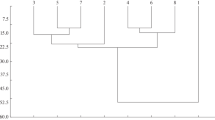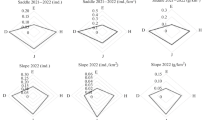Abstract
Since voles, mice and shrews are important animals in food chains of river floodplains, there is a need for data on their spatial and temporal distribution in periodically flooded areas. During a live trapping study between two successive floods in an embanked river floodplain, the ’Afferdensche en Deestsche Waarden (ADW)’, six species were frequently observed, viz,Microtus arvalis (Pallas, 1778),Clethrionomys glareolus (Schreber, 1780),Sorex araneus (Linnaeus, 1758),Crocidura russula (Hermann, 1780),Micromys minutus (Pallas, 1771) andApodemus sylvaticus (Linnaeus, 1758). Ungrazed rough herbaceous vegetation appeared to be rich in numbers and species, whereas no spoors of small mammals were observed in large parts of the ADW floodplain (eg bare substrates and maize fields). Vegetation structure seemed to be very important in guiding the recolonisation process after flood events. Throughout the year the highest numbers of small mammals were captured on and near the non-flooded elevated parts functioning as refugia during inundation. Poor habitat connectivity, sparseness of non-flooded recolonisation sources and small numbers of survivors led to slow recolonisation. The time between two successive floods (eight months) was not long enough for entire recolonisation of ADW. Small mammal densities at more than 30 m from the non-flooded areas were always lower than in non-flooded areas.
Similar content being viewed by others
References
Agrell J., Erlinge S., Nelson J. and Sandell M. 1992. Body weight and population dynamics: cyclic demography in a noncyclic population of the field vole (Microtus agrestis). Canadian Journal of Zoology 70: 494–501.
Alibhai S. K. and Gipps J. H. W. 1985. The population dynamics of bank voles. Symposia of the Zoological Society of London 55: 277–313.
Andersen D. C., Wilson K. R., Miller M. S. and Falck M. 2000. Movement patterns of riparian small mammals during predictable floodplain inundation. Journal of Mammalogy 81: 1087–1099.
Andrzejewski R. and Babińska-Werka J. 1986. Bank vole populations: Are their densities really high and individual home range small? Acta Theriologica 31: 409–422.
Bergstedt B. 1966. Home ranges and movements of the rodent speciesClethrionomys glareolus (Schreber),Apodemus flavicollis (Melchior) andApodemus sylvaticus (Linnaeus) in southern Sweden. Oikos 17: 150–157.
Boyce C. C. K. and Boyce III J. L. 1988a. Population biology ofMicrotus arvalis. II. Natal and breeding dispersal of females. Journal of Animal Ecology 57: 723–736.
Boyce C. C. K. and Boyce III J. L. 1988b. Population biology ofMicrotus arvalis. III. Regulation of numbers and breeding dispersion of females. Journal of Animal Ecology 57: 737–754.
Braun-Blanquet J., Fuller G. D. and Shoemaker Conard H. 1932. Plant sociology; the study of plant communities, 1st ed., McGraw-Hill Book Company, Inc., London: 1–439.
Bujalska G. 1970. Reproduction stabilizing elements in an island population ofClethrionomys glareolus (Schreber 1780). Acta Theriologica 15: 381–412.
Churchfield S. 1980. Population dynamics and the seasonal fluctuations in numbers of the common shrew in Britain. Acta Theriologica 25: 415–424.
Crawley M. C. 1969. Movements and home ranges ofClethrionomys glareolus (Schreber) andApodemus sylvaticus L. in North-east England. Oikos 20: 310–319.
Crespin L., Verhagen R., Stenseth N. C., Yoccoz N. G., Prévot-Julliard A.-C. and Lebreton J.-D. 2002. Survival in fluctuating bank vole populations: seasonal and yearly variations. Oikos 98: 467–479.
Dickman C. R. 1975. Estimation of population density in the Common shrew,Sorex araneus, from a conifer plantation. Notes From The Mammal Society 41: 550–552.
Erlinge S., Göransson G., Hansson L., Högstedt G., Liberg O., Nilsson I. N., Nilsson T., Von Schantz T. and Sylvén M. 1983. Predation as a regulating factor on small rodent populations in southern Sweden. Oikos 40: 36–52.
Favre L., Balloux F., Goudet J. and Perrin N. 1997. Female-biased dispersal in the monogamous mammalCrocidura russula: evidence from field data and microsatellite patterns. Proceedings of the Royal Society of London; Series B 264: 127–132.
Geuse P., Bauchau V. and Le Boulengé E. 1985. Distribution and population dynamics of bank voles and wood mice in a patchy woodland habitat in central Belgium. Acta Zoologica Fennica 173: 65–68.
Gliwicz J. 1989. Individuals and populations of the bank vole in optimal, suboptimal and insular habitats. Journal of Animal Ecology 58: 237–247.
Gurnell J. and Flowerdew J. R. 1990. Live trapping small mammals. A practical guide. 2nd Edition. An occasional publication of The Mammal Society: no. 3, London, UK: 1–39.
Hanski I., Henttonen H., Korpimäki E., Oksanen L. and Turchin P. 2001. Small-rodent dynamics and predation. Ecology 82: 1505–1520.
Hansson L. 1997. Population growth and habitat distribution in cyclic small rodents: to expand or to change? Oecologia 112: 345–350.
Hendriks A. J., Ma W.-C., Brouns J. J., De Ruiter-Dijkman E. M. and Gast R. 1995. Modelling and monitoring organochlorine and heavy metal accumulation in soils, earthworms, and shrews in Rhine-delta floodplains. Archives of Environmental Contamination and Toxicology 29: 115–127.
Jorgensen E. E. 2002. Small mammals: consequences of stochastic data variation for modeling indicators of habitat suitability for a well-studied resource. Ecological Indicators 1: 313–321.
Junk W. J., Bayley P. B. and Sparks R. E. 1989. The flood pulse concept in river-floodplain systems. [In: Proceedings of the International Large River Symposium. D. P. Dodge, ed]. Canadian Special Publication of Fisheries & Aquatic Sciences 106: 110–127.
Kikkawa J. 1964. Movement, activity and distribution of the small rodentsClethrionomys glareolus andApodemus sylvaticus in woodland. Journal of Animal Ecology 33: 259–299.
Kooistra L., Huijbregts M. A. J., Ragas A. M. J., Wehrens R. and Leuven R. S. E. W. 2005. Spatial variability and uncertainty in ecological risk assessment: a case study on the potential risk of cadmium for the little owl in a Dutch river floodplain. Environmental Science & Technology 39: 2177–2187.
Korn H. 1986. Changes in home range size during growth and maturation of the wood mouse (Apodemus sylvaticus) and the bank vole (Clethrionomys glareolus). Oecologia 69: 623–628.
Krištofik J. 1999. Small mammals in floodplain forests. Folia Zoologica 48: 173–184.
Lange R., Twisk P., Van Winden A. and Van Diepenbeek A. 1994. [Mammals of Western Europe]. KNNV-uitgeverij, Utrecht, The Netherlands: 1–400. [In Dutch]
Leuven R. S. E. W., Wijnhoven S., Kooistra L., De Nooij R. J. W. and Huijbregts M. A. J. 2005. Toxicological constraints for rehabilitation of riverine habitats: a case study for metal contamination of floodplain soils along the Rhine.Archiv für Hydrobiologie Suppl. 155: 657–676.
Ma W.-C. and Talmage S. 2001. Insectivora. [In: Ecotoxicology of wild mammals. R. F. Shore and B. A. Rattne, eds]. John Wiley &Sons Ltd: 123–158.
Montgomery W. I. 1989. Population regulation in the wood mouse,Apodemus sylvaticus. I. Density dependence in the annual cycle of abundance. Journal of Animal Ecology 58: 465–475.
Myllymäki A. 1977a. Demographic mechanisms in the fluctuating populations of the field voleMicrotus agrestis. Oikos 29: 468–493.
Myllymäki A. 1977b. Interactions between the field voleMicrotus agrestis and its microtine competitors in Central-Scandinavian populations. Oikos 29: 570–580.
Nelson J. 1995. Intrasexual competition and spacing behaviour in male field voles,Microtus agrestis, under constant female density and spatial distribution. Oikos 73: 9–14.
Pachinger K. and Haferkorn J. 1998. Comparisons of the small mammal communities in floodplain forests at the Danube and Elbe rivers. Ekológia (Bratislava) 17: 11–19.
Pelikán J., Zejda J. and Holišová V. 1974. Standing crop estimates of small mammals in Moravian forests. Zoologické Listy 23: 197–216.
Pernetta J. C. 1976. Diets of the shrewsSorex araneus L. andSorex minutus L. in Wytham grassland. Journal of Animal Ecology 45: 899–912.
Pusenius J. and Schmidt K. A. 2002. The effects of habitat manipulation on population distribution and foraging behavior in meadow voles. Oikos 98: 251–262.
Randolph S. E. 1977. Changing spatial relationships in a population ofApodemus sylvaticus with the onset of breeding. Journal of Animal Ecology 46: 653–676.
Rudge M. R. 1968. The food of the common shrewSorex araneus L. (Insectivora: Soricidae) in Britain. Journal of Animal Ecology 37: 565–581.
Smyth M. 1966. Winter breeding in woodland mice,Apodemus sylvaticus, and voles,Clethrionomys glareolus andMicrotus agrestis, near Oxford. Journal of Animal Ecology 35: 471–485.
Southern H. N. 1965. Handbook of British Mammals. Mammal Society of the British Isles. Blackwell Scientific Publications, Oxford, UK: 1–465.
Stelter C., Reich M., Grimm V. and Wissel C. 1997. Modelling persistence in dynamic landscapes: Lessons from a metapopulation of the grasshopperBryodema tuberculata. Journal of Animal Ecology 66: 508–518.
Szacki J. 1987. Ecological corridor as a factor determining the structure and organization of a bank vole population. Acta Theriologica 32: 31–44.
Tapper S. 1979. The effect of fluctuating vole numbersMicrotus agrestis on a population of weaselsMustela nivalis on farmland. Journal of Animal Ecology 48: 603–617.
Ter Braak C. J. F. and Smilauer P. 1998. CANOCO reference manual and user’s guide to Canoco for Windows: software for canonical community ordination (version 4). Centre for Biometry, Wageningen, The Netherlands.
Van Apeldoorn R. C., Oostenbrink W. T., Van Winden A. and Van der Zee F. F. 1992. Effects of habitat fragmentation on the bank vole,Clethrionomys glareolus, in an agricultural landscape. Oikos 65: 265–274.
Van der Velde G., Leuven R. S. E. W. and Nagelkerken I. 2004. Types of river ecosystems. [In: Fresh surface water. Encyclopedia of life support systems (EOLSS). J. C. I. Dooge, ed]. Developed under the auspices of the UNESCO, EOLSS Publishers Co. Ltd., Oxford, UK: 1–29, (www.eolss.net).
Ward J. V., Tockner K., Uehlinger U. and Malard F. 2001. Understanding natural patterns and processes in river corridors as the basis for effective river restoration. Regulated Rivers: Research & Management 17: 311–323.
Wolff J. O. 1998. Behavioural model systems. [In: Landscape ecology of small mammals. G. W. Barrett and J. D. Peles, eds]. Springer: 11–40.
Wolton R. J. and Flowerdew J. R. 1985. Spatial distribution and movements of woodmice, yellownecked mice and bankvoles. Symposium of the Zoological Society of London 55: 249–275.
Zandberg B. 1999. [’Afferdensche en Deestsche Waarden’ floodplain; Plan of arrangement]. Report 99.001. Directorate-General of Public Works and Water Management, Arnhem, The Netherlands. [In Dutch]
Zejda J. 1976. The small mammal community of a lowland forest. Acta Scientiarum Naturalium Brno 10: 1–39.
Zejda J. 1991. A community of small terrestrial mammals. [In: Floodplain forest ecosystem 1. M. Penka, M. Vyskot, E. Klimo and F. Vašièek, eds]. Elsevier: 357–371.
Zejda J. and Pelikán J. 1969. Movements and home ranges of some rodents in lowland forests. Zoologické Listy 18: 143–162.
Zorn M. I., Van Gestel C. A. M. and Eijsackers H. 2005. Species-specific earthworm population responses in relation to flooding dynamics in a Dutch floodplain soil. Pedobiologia 49: 189–198.
Author information
Authors and Affiliations
Additional information
Associate Editors were Leszek Rychlik and Karol Zub.
Rights and permissions
About this article
Cite this article
Wijnhoven, S., Van Der Velde, G., Leuven, R.S.E.W. et al. Flooding ecology of voles, mice and shrews: the importance of geomorphological and vegetational heterogeneity in river floodplains. Acta Theriol 50, 453–472 (2005). https://doi.org/10.1007/BF03192639
Received:
Accepted:
Issue Date:
DOI: https://doi.org/10.1007/BF03192639




